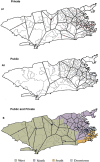Intensive care inequity in Rio de Janeiro: the effect of spatial distribution of health services on severe acute respiratory infection
- PMID: 32401976
- PMCID: PMC7206958
- DOI: 10.5935/0103-507x.20200012
Intensive care inequity in Rio de Janeiro: the effect of spatial distribution of health services on severe acute respiratory infection
Abstract
Objective: To analyze the distribution of adult intensive care units according to geographic region and health sector in Rio de Janeiro and to investigate severe acute respiratory infection mortality in the public sector and its association with critical care capacity in the public sector.
Methods: We evaluated the variation in intensive care availability and severe acute respiratory infection mortality in the public sector across different areas of the city in 2014. We utilized databases from the National Registry of Health Establishments, the Brazilian Institute of Geography and Statistics, the National Mortality Information System and the Hospital Admission Information System.
Results: There is a wide range of intensive care unit beds per capita (from 4.0 intensive care unit beds per 100,000 people in public hospitals in the West Zone to 133.6 intensive care unit beds per 100,000 people in private hospitals in the Center Zone) in the city of Rio de Janeiro. The private sector accounts for almost 75% of the intensive care unit bed supply. The more developed areas of the city concentrate most of the intensive care unit services. Map-based spatial analysis shows a lack of intensive care unit beds in vast territorial extensions in the less developed regions of the city. There is an inverse correlation (r = -0.829; 95%CI -0.946 to -0.675) between public intensive care unit beds per capita in different health planning areas of the city and severe acute respiratory infection mortality in public hospitals.
Conclusion: Our results show a disproportionate intensive care unit bed provision across the city of Rio de Janeiro and the need for a rational distribution of intensive care.
Objetivo: Analisar a distribuição das unidades de terapia intensiva para adultos, segundo a região geográfica e o setor sanitário no Rio de Janeiro, e investigar a mortalidade por infecção respiratória aguda grave no setor público e sua associação com a capacidade de terapia intensiva no setor público.
Métodos: Avaliamos a variação da disponibilidade de terapia intensiva e a mortalidade por infecção respiratória aguda grave no setor público em diferentes áreas da cidade em 2014. Utilizamos as bases de dados do Cadastro Nacional de Estabelecimentos de Saúde, do Instituto Brasileiro de Geografia e Estatística, do Sistema de Informações sobre Mortalidade e do Sistema de Informações Hospitalares do SUS.
Resultados: Foi ampla a variação na disponibilidade de leitos em unidades de terapia intensiva per capita (desde 4,0 leitos de terapia intensiva por 100 mil habitantes em hospitais públicos na zona oeste até 133,6 leitos em unidades de terapia intensiva por 100 mil habitantes nos hospitais privados na zona central) na cidade do Rio de Janeiro. O setor privado respondeu pelo suprimento de quase 75% dos leitos em unidades de terapia intensiva. Uma análise espacial com base em mapas mostrou falta de leitos em unidades de terapia intensiva em vastas extensões territoriais nas regiões menos desenvolvidas da cidade. Houve correlação inversa (r = -0,829; IC95% -0,946 - -0,675) entre a quantidade de leitos públicos em unidade de terapia intensiva per capita em diferentes áreas de planejamento em saúde na cidade e a mortalidade por infecção respiratória aguda grave em hospitais públicos.
Conclusão: Nossos resultados mostram disponibilidade desproporcional de leitos em unidades de terapia intensiva na cidade do Rio de Janeiro e a necessidade de uma distribuição racional da terapia intensiva.
Conflict of interest statement
Figures



Similar articles
-
Variation in critical care services across North America and Western Europe.Crit Care Med. 2008 Oct;36(10):2787-93, e1-9. doi: 10.1097/CCM.0b013e318186aec8. Crit Care Med. 2008. PMID: 18766102 Review.
-
Planning and understanding the intensive care network in the State of Rio de Janeiro (RJ), Brazil: a complex societal problem.Rev Bras Ter Intensiva. 2018 Jul-Sept;30(3):347-357. doi: 10.5935/0103-507X.20180053. Rev Bras Ter Intensiva. 2018. PMID: 30328988 Free PMC article.
-
National audit of critical care resources in South Africa - unit and bed distribution.S Afr Med J. 2007 Dec;97(12 Pt 3):1311-4. S Afr Med J. 2007. PMID: 18265911
-
Difficulties in access and estimates of public beds in intensive care units in the state of Rio de Janeiro.Rev Saude Publica. 2016;50:19. doi: 10.1590/S1518-8787.2016050005997. Epub 2016 May 13. Rev Saude Publica. 2016. PMID: 27191155 Free PMC article.
-
Pediatric intensive care in Argentina.Crit Care Med. 1993 Sep;21(9 Suppl):S403-4. doi: 10.1097/00003246-199309001-00071. Crit Care Med. 1993. PMID: 8365259 Review.
Cited by
-
COVID-19 Pandemic in Rio de Janeiro, Brazil: A Social Inequality Report.Medicina (Kaunas). 2021 Jun 10;57(6):596. doi: 10.3390/medicina57060596. Medicina (Kaunas). 2021. PMID: 34200557 Free PMC article.
References
-
- Paim J, Travassos C, Almeida C, Bahia L, Macinko J. The Brazilian health system: history, advances, and challenges. Lancet. 2011;377(9779):1778–1797. - PubMed
-
- Viacava F. Acesso e uso de serviços de saúde pelos brasileiros. RADIS. 10(96):12–19.
-
- Victora CG, Barreto ML, do Carmo Leal M, Monteiro CA, Schmidt MI, Paim J, Bastos FI, Almeida C, Bahia L, Travassos C, Reichenheim M, Barros FC, Lancet Brazil Series Working Group Health conditions and health-policy innovations in Brazil: the way forward. Lancet. 2011;377(9782):2042–2053. - PubMed
-
- Macinko J, Harris MJ. Brazil's family health strategy--delivering community-based primary care in a universal health system. N Engl J Med. 2015;372(23):2177–2181. - PubMed
-
- Osorio RG, Servo LM, Piola SF. [Unmet health care needs in Brazil: an investigation about the reasons for not seeking health care] Cienc Saude Colet. 2011;16(9):3741–3754. Portuguese. - PubMed
Publication types
MeSH terms
LinkOut - more resources
Full Text Sources
Medical

